Japanese maples - an original decoration of the garden

Japanese maples are unusually beautiful plants that can fill the garden with the brightest colors, and the leaves of numerous species and subspecies of these amazing plants have a rich spectrum of shades. However, when planting this decorative miracle and in the process of further caring for them, it is important to take into account a number of their inherent features. Only then can the health, splendor and beauty of these wonderful Japanese "guests" be guaranteed.
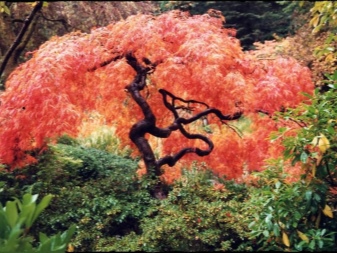

Peculiarities
Regarding the general description of the Japanese red-leaved maple, we note that this is a collective name. In fact, this name covers many species that grow in their homeland - in Japan and South Korea.
Maples belong to the sapind family (genus maple). There are about 150 varieties of them, some of them penetrated into our lands from Southeast Asia.
Several varieties of it grow in Russia. The tree belongs to deciduous perennial plants and reaches a height of 10 m. Low-growing and dwarf maples (up to 1.5 m in height) are popular in landscape design. In 1784 A. Murray gave a rather extensive description of it, and the scientist-naturalist from Sweden K. Thunberg worked intensively in the same direction.


Maple tree leaves:
- rounded, serrated (with oblique small teeth), oppositely located, with a diameter of up to 15 cm;
- cut by almost 1/2 of the diameter or more (by grade);
- 7-, 9- or 11-part;
- keep on thin petioles about 5 cm long;
- the color can be green (in summer), bright carmine, poisonous scarlet, crimson with yellow and orange inclusions (in autumn);
- the name of the plants was determined by the shape of the leaf - palm-leaved, fan-shaped or palm-shaped.



During the flowering period (April-June), the flowers are slightly pubescent, located in long shields, up to 3 cm long. The color can be bright purple-red or pale green-yellow. Then they transform into lionfish hanging under the leaves.


Maples grow mainly in mixed forests on mountain slopes. The natural area of their growth in Russia is reputed to be about. Kunashir of the South Kuril region of Sakhalin. Nowadays it is listed in the Red Book of the country.
In October, when in Japan maples stand out with their color, this period is called momiji ("red leaves"). Since the birthplace of maples is Japan, the winter hardiness of these plants can be called low.


Popular species and varieties
Due to the significant distribution of maples in gardening and landscape design, quite a lot of its species and varieties have appeared. Such a variety of its varieties allows you to make the desired choice for the ideal compositional solution of the site. Nevertheless, there are 3 leading types of maples:
-
palm-shaped, or fan-shaped, or palm-leaved;



-
Shirasawa maple (shirasawanum);
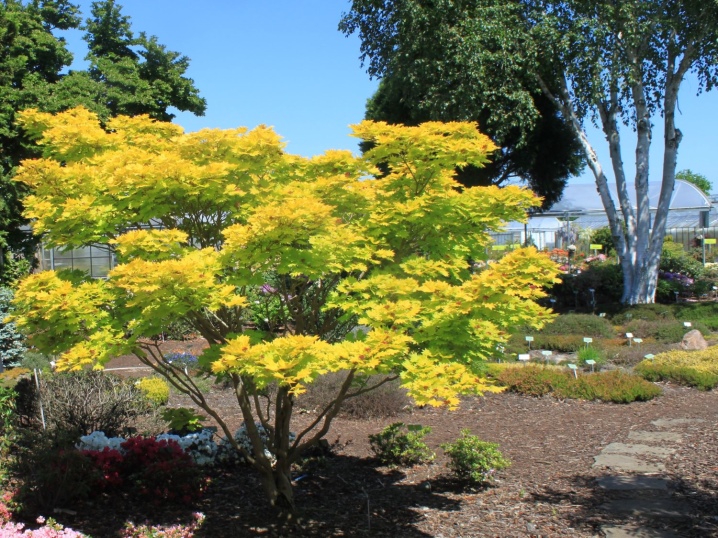
- proper Japanese (japonicum).

Other subspecies and varieties (red-leaved, holly, frost-resistant and others) are distinguished among them.
- Maple of Shirasawa - a kind of dwarf shrub (height not more than 1.5 m). The plant is broad-leaved, acquiring a bright yellow color with an orange-red tint in autumn. There are several subspecies of it.


- Beni Kawa - in the fall it looks like a red flame (red-leaved) in the garden. It has a ruby bark and rich, juicy red foliage.


- Katsura - variety with leaves of golden lemon color.
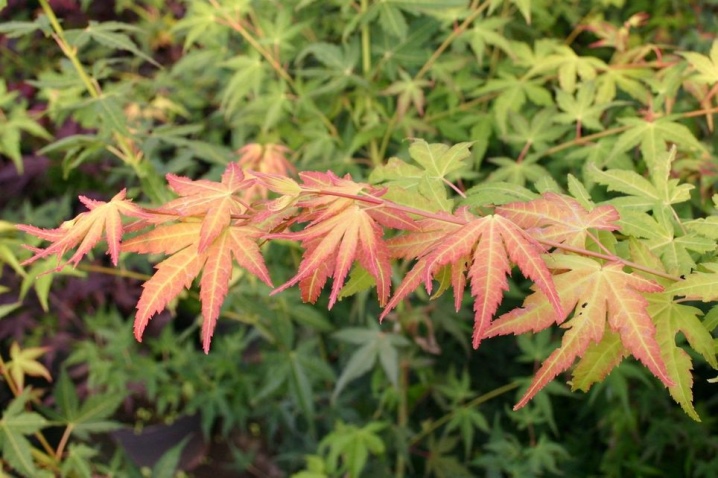
- Bloodgood - a rare subspecies, characterized by dark shades of foliage.

- Mikawa yatsubusa - undersized shrub with needle-shaped leaves, bright green in summer, and orange-scarlet in autumn.
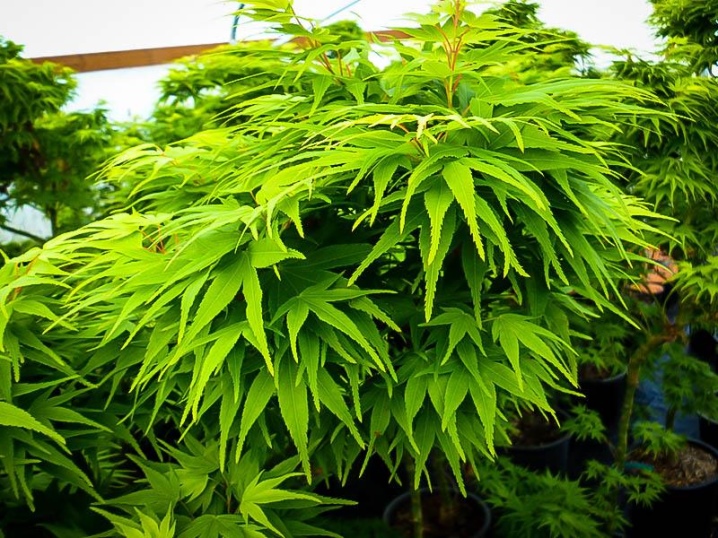
- "Atropurpureum" (Atropurpureum) - with an umbrella-shaped crown, gorgeous looking and without leaves. The foliage is purple in summer. It can reach a length of 3-4 m. In Russia, it is often grown in large garden containers.

- Aconitifolium (Aconitifolium) - with beautifully carved leaves cut to the base. With foliage of bright green color in summer, in autumn - crimson-scarlet.

- "Dissectum" (Dissectum) - with filigree finger-dissected foliage with 5, 7 or 9 serrated protrusions up to 12 cm. In summer, with a rich red-brown color. In autumn, a brighter carmine red with various inclusions of yellow, purple, bronze color


- Shaina - a low-growing species, with a maximum height of 1.5 m. With long palm-like, cut leaves, with a dense, bushy and dense crown. Requires regular pruning for good ventilation. The shapes are spherical, holds the formative cut well. In the fall of a bright blood-red color scheme, focusing all the attention on itself. It is often placed in large containers in the corners of garden areas. They can often be seen in hotel lobbies, on terraces and verandas.

- Kiyohime - the most ideal, including indoor view for bonsai and potted growth. An example of a dwarf slow-growing variety with a maximum length of 1.8 m. It has carved palm-like leaves with small thin tips. In the central part of the leaf there are pale green shades, along the edges - bright red and yellow.
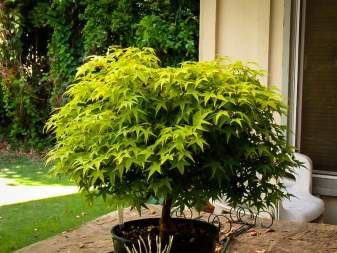

- Aka shigitatsu sawa - an original and unusually beautiful subspecies, remarkable for its spread-out carved leaves that retain their rich greenish shades for a long time. However, the veins and margins are bright red or yellow. The leaves look like palms with translucent veins and capillaries. Dense crown requiring regular pruning. The culture is high, capable of reaching 3 m in length.
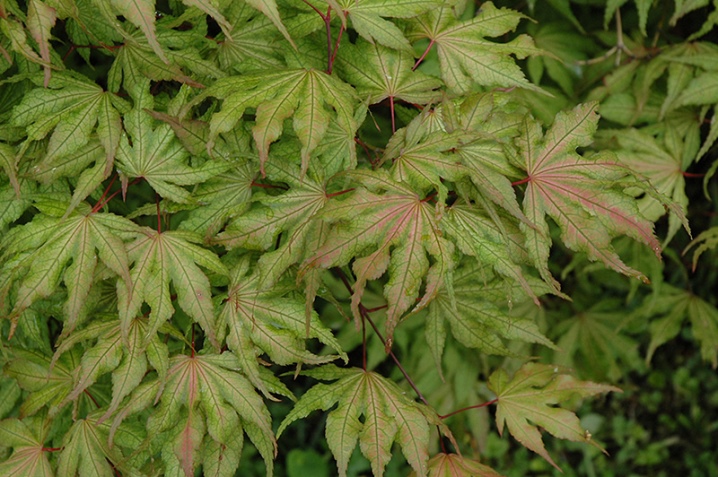
- Wilson's Pink Dwarf - a decorative subspecies of maple, growing up to 2.5 m, with beautiful red foliage in autumn. In the sunlight, it plays with orange hues.


- Shirazz - an extremely spectacular subspecies, with deeply dissected green leaves bordered by a bright crimson stripe. In autumn, they turn purple in color.

Landing
If you do not have time for seeds, buy seedlings, which during the planting season should be carefully examined when buying for the presence of diseases and strength. Weak seedlings usually do not take root.
Saplings love competent and careful planting, taking into account all the features that this delicate plant possesses.
- You should choose non-alkaline soils, with light moisture, without water stagnation.... Drainage of the soil is mandatory.
- It is better to choose a landing place with light shade, but occasional exposure to direct sunlight.
- The actual moment when landing is considered avoiding drafts... Maple trees should be planted near walls, hedges, or covering them with conifers.
If you are planting a number of seedlings, then they should be spaced apart from each other at a distance of 2-3 m, since maples have rather spreading crowns.

Basic landing rules:
- in depth, the planting hole should be 2 times the root system of the seedling;
- we organize drainage;
- for clay soil, add sand;
- we lower the seedling into the rooting solution for about 15 minutes;
- then we place it in the hole, gently spreading the roots;
- sprinkle with the previously harvested soil mixture (earth, peat and compost);
- we make out the near-trunk circle, tamping it;
- water abundantly;
- we apply fertilizers the next day;
- we mulch the trunk circle.

Care
Japanese maple is not considered an unpretentious plant to care for, since its homeland is the East, where climatic conditions are milder and warmer. Therefore, growing it in Russia in the open field is a rather troublesome event. You can take care of the plant according to a specific plan.
- Watering... Water it abundantly and regularly. The volume is determined based on precipitation and weather conditions. The trunk circle should not be allowed to dry out. At the same time, you need to ensure that the water does not stagnate in it. In especially hot weather, it is recommended to irrigate the crown with warm water in the evenings.

- Top dressing... The plant is clearly not indifferent to nutritious soils, and therefore it is fed with complex mineral fertilizers, applied both during planting and then regularly. It is preferable that nitrogen is not included in the added compounds.

- Mulching - the procedure is mandatory, since it prevents the drying of the trunk circle, helps to save the root system from various harmful influences. For mulching, conventional materials are used: pine needles, sawdust, peat material, composts, fallen dry leaves, etc. In addition to the practical purpose, this event also carries a considerable aesthetic load - a tree groomed in this way looks quite elegant.

- During the first 3-4 years, maples need formative pruning if you want to increase their decorative qualities.... Otherwise, the branches will begin to grow erratically, the crowns will begin to thicken, the ventilation system will be disrupted. As a result, the leaves will begin to dry out, the resistance of plants to diseases will decrease, and the risk of fungal infections will increase.

- After 4-5 years of growth, it is not necessary to cut the plant - it will now take on its permanent form... However, in spring and autumn, dryish, diseased, damaged twigs and shoots that interfere with normal ventilation of the top should be cut off.

- When preparing maples for winter, remember that these plants are not frost-resistant. The maximum temperature they can survive in winter is -20 ° C, but only under careful cover. The best option would be to root them in a tub: in the spring we take them out into the street, and in the fall we return them indoors. When wintering on the street, we think about protective measures in the fall, after the leaves have fallen: we mulch the trunk circle with peat or compost (5-7 cm), cover the open part with needles or burlap. Maple trees in Russia will not survive the winter without shelter. Even having taken the full range of necessary protective measures, one cannot be sure that the plants will wake up in the spring - they are too delicate.
Maple is often grown on the trunk of the common maple. But this kind of cultivation and care is only suitable for experienced gardeners.

Reproduction methods
There are two possible breeding options for the Japanese maple.
Seeds
It is not so difficult to propagate maples by seeds at home - one of the best ways:
- soak the seeds for 2-3 hours;
- we fill small containers (10x10 cm) with fertile soil;
- we lay the seeds at a depth of about 5 cm (each seed has a separate hole);
- cover with foil or glass;
- we remove in a lighted place, but without direct sunlight;
- every day for 2-3 hours we remove the shelters (for ventilation);
- we wait for the first leaves and plant the seedlings in open soil (or in a tub).
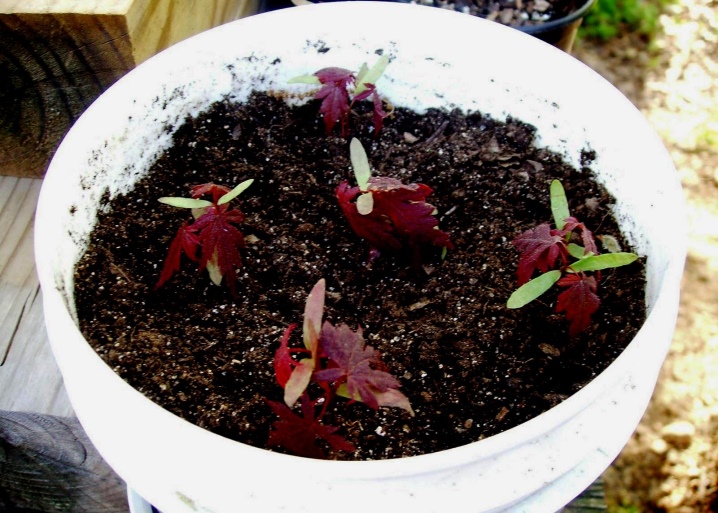
Cuttings
Reproduction of Japanese maples by cuttings is troublesome and not one hundred percent. The survival rate with this method is rather low compared to seed.
- In the spring, we choose strong, but young branches, on which the bark has not yet formed.
- At their bases, we make annular cuts for the development of the root system.
- A little higher (2-3 cm) we make a similar incision.
- We remove the thin skin between them.
- Apply a root-forming hormone to the prepared place. They are available in powder or gel form.
- We attach sphagnum (previously abundantly moistened) moss to the treated area to activate hormones.
- Cover the place with a piece of polyethylene. We leave the workpiece in a shaded and cool place.
- After 3-4 weeks, the roots begin to appear through the bandage.
- Remove the bandage. The stalk that gave the roots is planted in the ground.

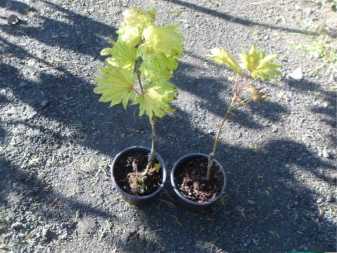
Diseases and pests
Speaking about the treatment and prevention of diseases of Japanese maples, we note that insect pests are not dangerous for them - maples are not to their taste... But the gall mite is a different matter. The twigs dry up, and the leaves lose their color. In such cases, the affected areas are eliminated, and the tree is treated with insecticides. Somewhat less often, trees are attacked by maple leaf weevils or whiteflies.
Powdery mildew is a dangerous fungal enemy. To protect the Japanese "guest" from her, it is necessary to plant him away from the fruit and berry bushes. If infection has occurred, then repeated (2-3 times) fungicidal treatment will be required.


Application in landscape design
Our Japanese "guests" are especially popular in landscape design - and not only in private plots, but also in city parks.
Possible applications:
-
in original garden compositions;

- like bonsai;

- in the form of an accented figure in the front gardens;

- in rockeries, mixborders and alpine slides;

- in decorative edging of reservoirs;

- in Japanese gardens;

- for growing in containers and pots, transferred from one place to another.
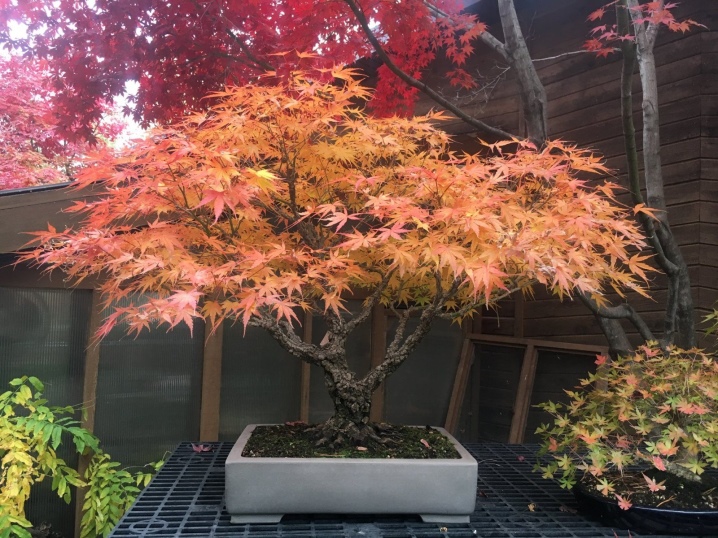
As part of a one-time composition, maple is in perfect harmony with ivy, honeysuckle, clematis, azalea, magnolia and hydrangea.

At home, "Japanese" perfectly moisturizes and enriches the microclimate with oxygen. It is an excellent neighbor for other horticultural crops, shrubs and cereals, since its moderate root system does not contribute to the oppression of nearby plants.
Taking into account that rockeries, alpine and Japanese gardens, green roofs have become widespread in recent years, Japanese "guests" may well become pearls in the listed ways of arranging free spaces.


Next, watch a video with a specialist's story about Japanese maple and the rules of caring for it.



































































The comment was sent successfully.